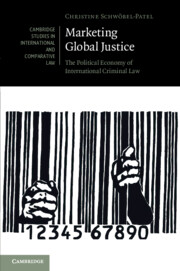Book contents
- Marketing Global Justice
- Cambridge Studies in International and Comparative Law: 152
- Marketing Global Justice
- Copyright page
- Contents
- Figures
- Acknowledgements
- 1 Introduction
- 2 Ad-Vocacy
- 3 A Brand New Justice
- 4 ‘A Picture Worth More Than a Thousand Words’
- 5 ‘Working It’
- 6 Kony 2012
- 7 Special Effects
- 8 Branding the Global (In)Justice Place
- 9 ‘Occupying’ Global Justice
- 10 Conclusion
- Select Bibliography
- Index
- Cambridge Studies in International and Comparative Law: 152
5 - ‘Working It’
The Brand of the Ideal Victim
Published online by Cambridge University Press: 22 March 2021
- Marketing Global Justice
- Cambridge Studies in International and Comparative Law: 152
- Marketing Global Justice
- Copyright page
- Contents
- Figures
- Acknowledgements
- 1 Introduction
- 2 Ad-Vocacy
- 3 A Brand New Justice
- 4 ‘A Picture Worth More Than a Thousand Words’
- 5 ‘Working It’
- 6 Kony 2012
- 7 Special Effects
- 8 Branding the Global (In)Justice Place
- 9 ‘Occupying’ Global Justice
- 10 Conclusion
- Select Bibliography
- Index
- Cambridge Studies in International and Comparative Law: 152
Summary
Contrary to the claims that global justice is for the benefit of victims of conflict, I propose that victims are exploited as the faces of global justice. The construction and reproduction (and normalising) of an ‘ideal victim’ brand is discussed. This chapter illustrates how the value of the victim rises or falls depending on how many marketable attributes the victim fulfils. The use and re-use of such attributes to define victimhood deepens and institutionalises existing stereotypes of a feminised, infantilised, and racialised notion of victimhood. The decision as to who is a perpetrator and who is a victim is presented, therefore, as reflecting political and economic power. Not only is the commodification of victimhood discussed, but also the alienation of victims as they inhabit notions of ‘ideal’ victimhood.
- Type
- Chapter
- Information
- Marketing Global JusticeThe Political Economy of International Criminal Law, pp. 127 - 150Publisher: Cambridge University PressPrint publication year: 2021

